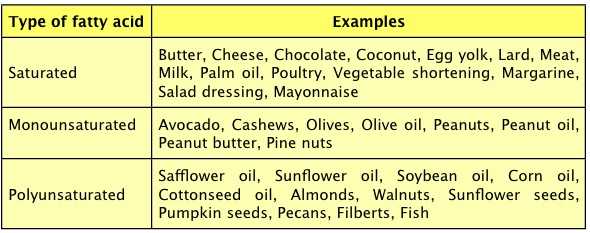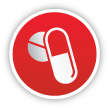What are the different types of fats?
95% of dietary fats exist as triglycerides, which are composed of three fatty acid molecules. Fatty acids can be either saturated or unsaturated.
- Saturated fatty acids are chock full of hydrogen molecules. This allows them to be transported directly to fat cells. The body makes saturated fatty acids, so they do not have to be supplied in the diet.
- Unsaturated fatty acids are of two types: monounsaturated and polyunsaturated. Unsaturated fatty acids have space for more hydrogen molecules, and therefore are biologically active and versatile.
The more saturated the fat, the more solid it is at room temperature. Polyunsaturated vegetable oil is liquid. Saturated animal fat as found on a piece of meat is solid.
Fats have many important functions:
- Structural components of cell membranes
- Protection for cell membranes and skin
- Storage and transport of fuel
- Hormones and steroids including chole-sterol
- Fat soluble vitamins: A, D, E, K
- Prostaglandins
What is cholesterol?
Good cholesterol versus bad?
Cholesterol is another fat that is contained in the diet and made by the body. Cholesterol is transported in the blood by lipoproteins. There are three types of lipoproteins with two basic functions.
- HDL (high density lipoprotein) helps the liver get rid of fat, removing it from the circulation, therefore it has been labeled “good cholesterol.”
- LDL (low density lipoprotein).
- VLDL (very low density lipoprotein).
LDL and VLDL deliver cholesterol and triglycerides to the fat storage deposits.
They keep the fats in circulation where they can clog the arteries, and therefore have been labeled “bad cholesterol”.
What are transfats?
Mono and polyunsaturated vegetable oils are liquid at room temperature. Saturated fats are solid. Unsaturated fats can be made solid by adding hydrogen, becoming partially hydrogenated. They are trans-formed chemically through hydrogenation or through high heat.
Transfats are found in margarine, vegetable shortening, snacks, crackers, cookies, and in deep-frying fats and oils.
We are sold products made of “100% polyunsaturated corn oil” that have been transformed. Once healthy vegetable oil is made into unhealthy, saturated fat.
Why are transfats used?
- Add crunchy texture to foods
- Reduce cost
- Prolong shelf life of fat and products with fat
Transfats increase LDL and decrease HDL. Transfats are easily taken up by fat cells, making weight loss more difficult. They decrease testosterone, disrupt immune function and raise insulin levels. For every 2% increase in transfat consumption there is a doubling of the risk for heart disease.
Are there established “daily minimum requirements” for fat?
The only fats that need to be supplied in the diet are linoleic acid, which comes from plant sources such as corn oil, and alpha-linoleic acid (omega 3 fatty acid) from soybean, canola and fish oils. All other fats can be made from carbohydrates in the diet and fat stored in the body.
There is no set minimum level for saturated fat, cholesterol or transfat. They have no role in the prevention of chronic disease and are not required at any level.
The risk to health rises at any intake level above zero. So the recommendation is to eat as little as is possible while consuming a diet adequate in other essential nutrients.
In 2003 the FDA mandated that transfat levels be included in nutrition labeling. A study showed that the transfat levels measured in the blood decreased 58% from 2000 to 2009. Similarly in 2007 Health Canada put forth an initiative to limit the transfats in all foods. Progress is being made.
Health facts about fat and cholesterol
- After a meal in saturated fats the blood serum (the portion without the red blood cells) turns milky white and thickens due to the circulating fat.
- Almost 70% of blood cholesterol is the bad type: LDL and VLDL.
- Low fat diets will decrease triglycerides and total cholesterol. Because total cholesterol decreases, HDL, LDL and VLDL all decrease. It is the ratio between HDL and LDL,VLDL that is important. While the HDL will decrease on a low fat diet, the percentage of good to bad cholesterol will increase.
- HDL is increased by exercise.
- HDL is increased when most dietary fats are polyunsaturated.
- There is an inverse relationship between Body Mass Index and HDL: higher BMI (more overweight), lower HDL.



